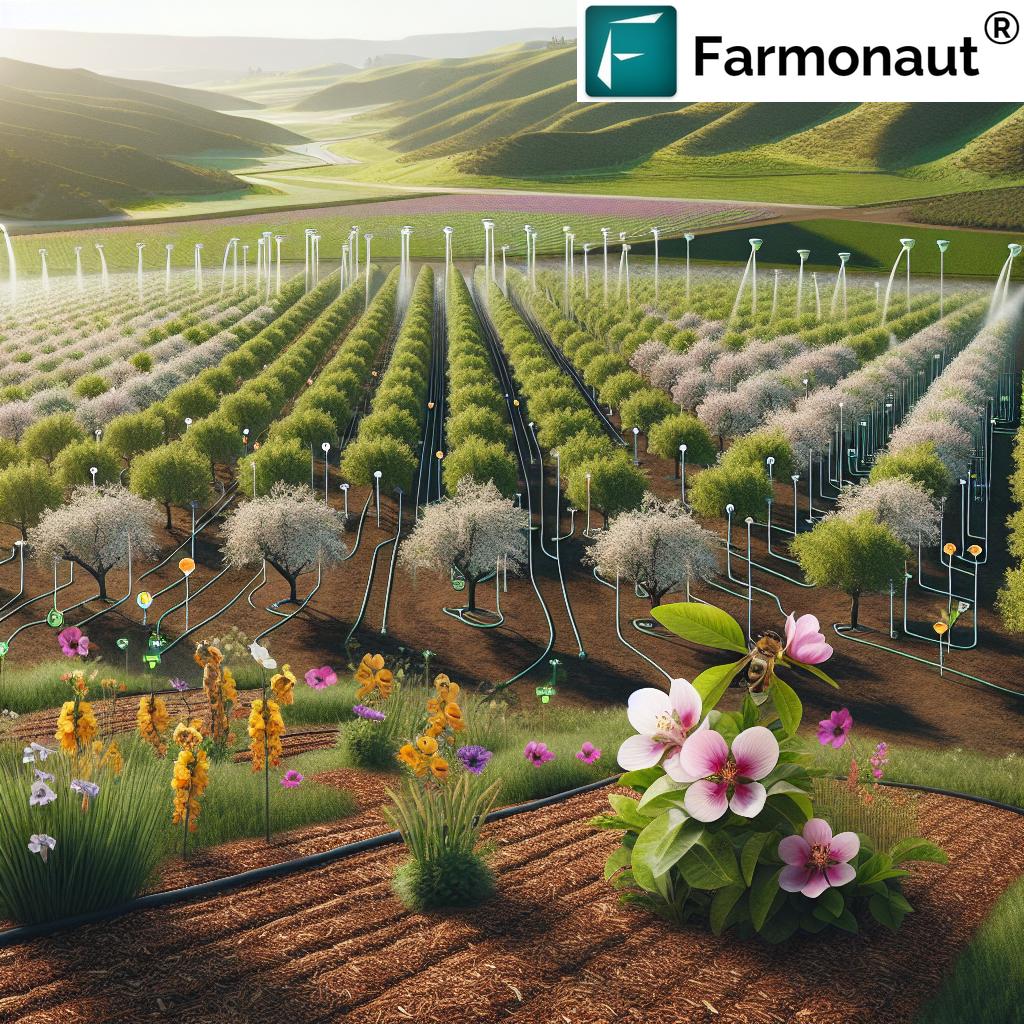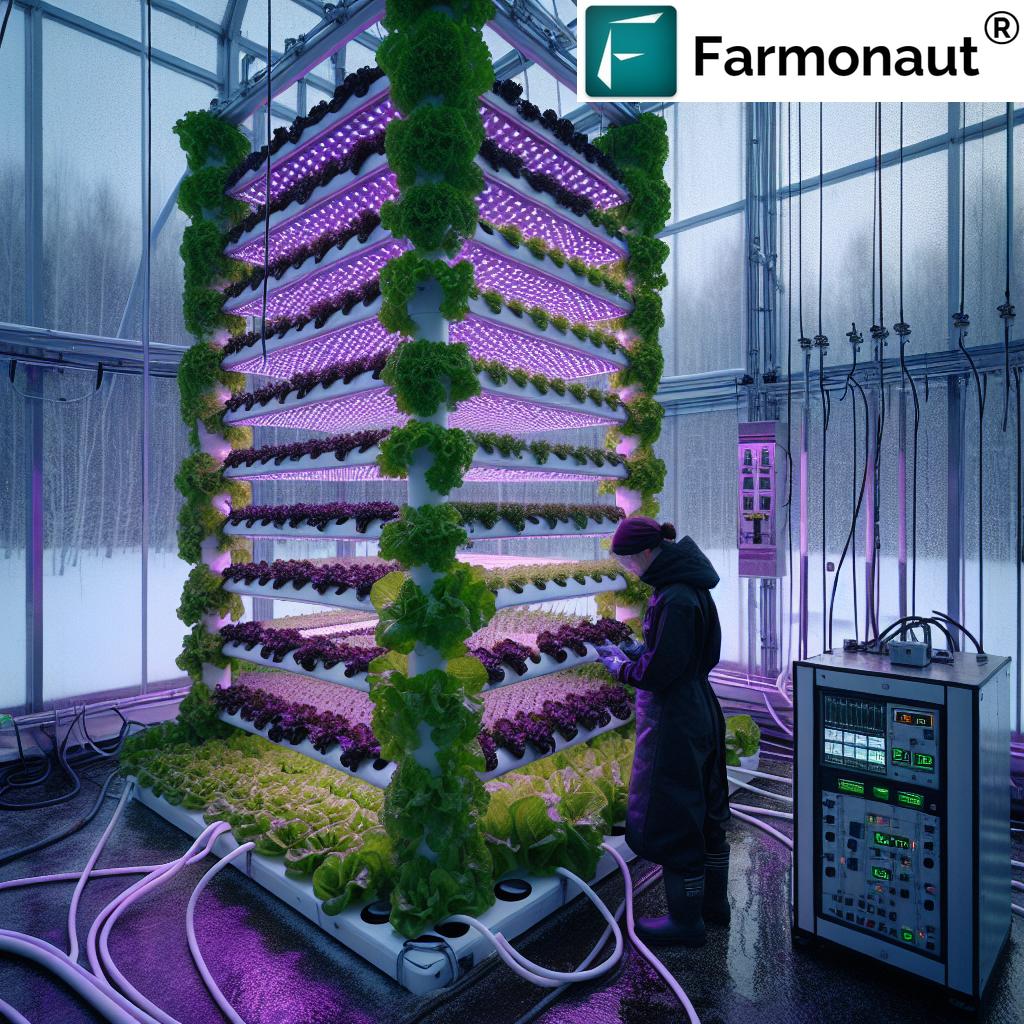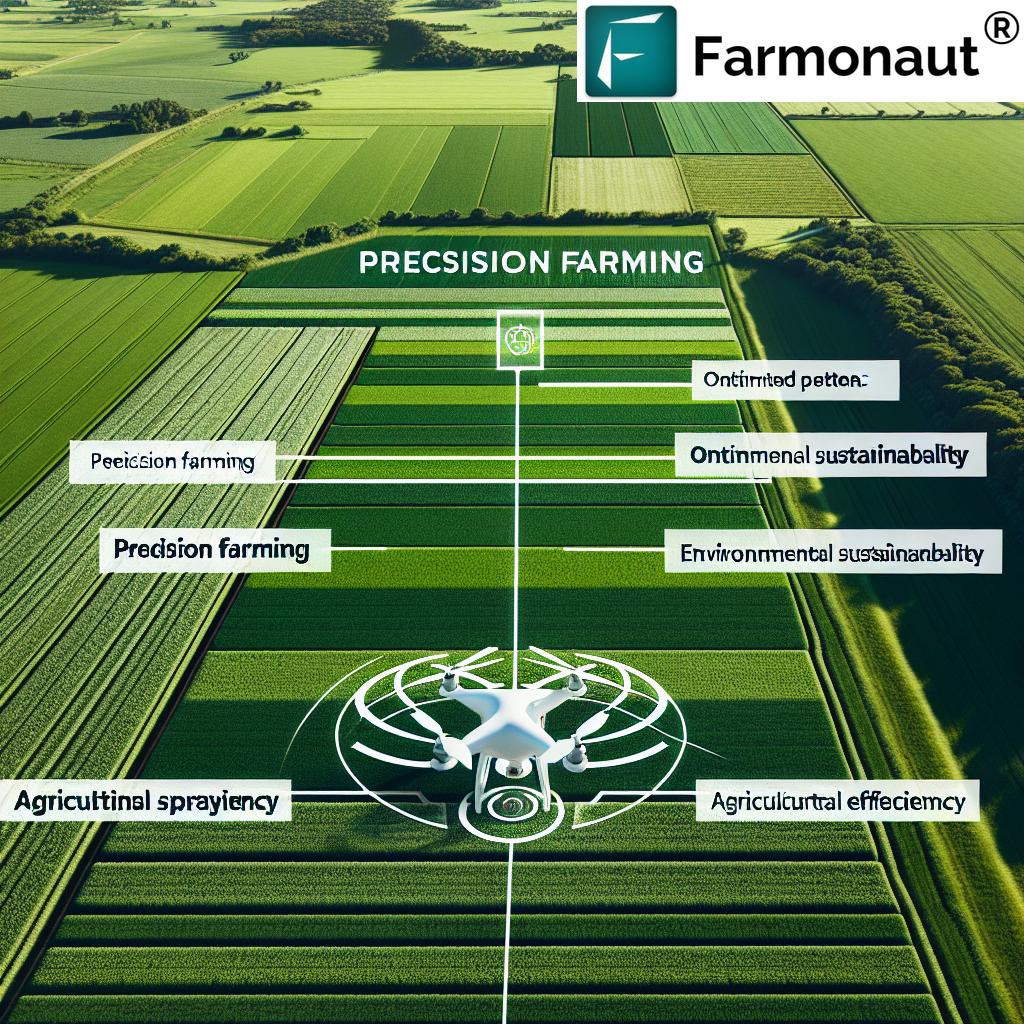Is Almond Farming Sustainable? Shocking Truths Revealed!
“California almond orchards use about 3.2 million acre-feet of water annually—enough to supply over 6 million households!”
Table of Contents
- Introduction: The Almond Industry in California & Global Context
- Almond Water Usage: Fact vs. Fiction
- Pollinator Health and Almonds: Why Bees Matter
- Reducing Pesticide Use in Almonds: Toward Integrated Pest Management
- The Carbon Footprint of Almonds: Almond Orchards as Carbon Sinks
- Almond Waste Reduction Strategies: Achieving Zero Waste
- Economic and Social Impacts of Almond Farming
- How Technology Drives Sustainable Almond Cultivation: A Farmonaut Perspective
- Comparative Impact Table: Traditional vs. Sustainable Almond Farming Practices
- FAQ: Almond Farming Sustainability
- Conclusion: Can We Achieve Truly Sustainable Almond Farming?
Introduction: The Almond Industry in California & Global Context
When we talk about almond farming, we’re discussing much more than a popular snack or plant-based milk. We’re talking about an industry deeply woven into California’s economy, culture, and environment. California’s almond orchards don’t just dominate the U.S. scene—over 80% of the world’s almonds are produced in California, making the state the undisputed global powerhouse for almond cultivation and trade.
Yet, with great influence comes great responsibility. The almond industry environmental impact is the subject of passionate debate—especially questions regarding water usage, impact on pollinators like bees, dependence on pesticides, carbon footprint, as well as waste management. Each of these concerns has prompted researchers, consumers, and, most importantly, farmers themselves to reconsider almond farming practices in search of a truly sustainable model.
In this comprehensive guide, we’ll explore the shocking truths, dispel myths, examine sustainability challenges, and spotlight innovative solutions—including the vital role of agri-tech like Farmonaut’s precision agriculture platform, which helps manage resources, monitor crop health, and reduce environmental issues. Join us as we journey from the roots of California’s almond trees to the future of sustainable almond cultivation.
How Farmonaut’s Satellite Technology is Revolutionizing Land Use in Agriculture
Almond Water Usage: Fact vs. Fiction
Water is at the center of the almond farming sustainability debate. As droughts intensify and water becomes scarce in California, the finger often points to almond trees, regularly accused of being water hogs. So, how thirsty are almonds, and what steps are we taking to reduce almond water usage?
Understanding Almond Water Consumption
According to estimates, producing a single almond requires about 1.1 gallons of water. Into the bigger picture, California almond orchards collectively use about 3.2 million acre-feet of water annually (Enviroliteracy.org). That’s enough to supply over 6 million households each year!
-
Why so much water?
Almond trees are perennial and require year-round irrigation to maximize growth and yield—not just seasonal watering like some crops. The extensive root structures of almond trees demand a steady supply, particularly during hot, dry periods. The region’s semi-arid climate amplifies these requirements, making sustainable irrigation crucial. -
How does this compare to other crops?
While almond water usage is significant, it is sometimes misrepresented. For instance, 100 grams of California almonds require roughly 1,600 liters of water—less than pistachios and walnuts, but more than oranges or grapes. The crucial question is not just “how much water” but “how efficiently is it being used?”
Advanced Irrigation Techniques & Achieving Water Efficiency
Recognizing these challenges, the almond industry is proactively addressing water consumption. How? By deploying advanced techniques aimed at reducing water usage while sustaining high yields:
- Drip Irrigation: The most effective technique, delivering water directly to tree roots, thereby minimizing surface evaporation and runoff.
- Sensors and Soil Moisture Monitoring: Many farmers are now integrating satellite-based crop health and soil moisture tracking tools—such as the solutions offered by Farmonaut. With real-time data, farmers fine-tune irrigation schedules, reducing unnecessary watering and ensuring each drop counts.
- Building Upon Past Successes: The California Almond Board reports a 33% reduction in water use since the 1990s. The goal is to further reduce water usage by 20% by 2025 (almonds.com), cementing a commitment to ongoing improvement.
Did You Know?
Farmonaut offers large scale farm management tools that incorporate satellite data for monitoring soil moisture and irrigation efficiency across entire orchards. This helps orchard managers align with sustainability goals by minimizing water wastage and maximizing productivity.
Why Precision Matters: An Almond Grower’s Perspective
We see firsthand how optimizing irrigation reduces not just water use, but also nutrient loss and disease risk in almond orchards. Drip irrigation, supported by sensors and Farmonaut’s real-time field insights, is now the benchmark for sustainable almond cultivation. As we continue to adopt smarter technologies and more efficient practices, we move closer to an almond industry that thrives while reducing its environmental footprint.
Unlocking Soil Organic Carbon: The Secret to Sustainable Farming with Farmonaut
Pollinator Health and Almonds: Why Bees Matter
“Over 80% of the world’s almonds are grown in California, making pollinator health crucial for global almond sustainability.”
Let’s not overlook the critical relationship between almond orchards and bees. Almond trees rely almost exclusively on insect pollination, making the health of honeybees and native pollinators pivotal for their success. As California almond orchards bloom each spring, more than 2 million bee colonies are transported across the United States just to pollinate these trees.
Pollinator Health: Worries for Bees and the Almond Industry
- Stress & Mortality: The large-scale movement and concentration of colonies cause significant stress and higher mortality rates among bees. This has concerning implications for both bee populations and the almond industry’s reliability.
- Pesticide Exposure: Sub-lethal pesticide exposure during and after pollination periods adds an extra layer of risk.
- Food Scarcity: Once the almond bloom ends (which lasts for just a few weeks), bees often struggle to find supplemental food sources, contributing to weakened colonies.
How Farmers Address Pollinator Health and Almond Sustainability
Sustainable almond farming practices now prioritize support for pollinators, focusing on long-term health for both orchards and bees. Methods include:
- Planting Wildflowers: Bordering almond orchards with wildflower strips provides bees with continuous food sources and habitats.
- Timing Pesticide Use: By restricting applications during bloom or using bee-friendly IPM strategies, we directly reduce stress and mortality among pollinators.
- Working with Conservation Organizations: Groups like the Pollinator Partnership and Xerces Society are collaborating with farmers to implement pollinator-friendly practices (Harris Woolf Almonds).
- Integration with Modern Technologies: Food sources and pollinator activity can be mapped with Farmonaut’s precision monitoring platform—helping farmers identify optimal locations for wildflower planting or changes in orchard management.
The commitment to fostering strong pollinator health and almonds ensures that our trees are productive and the greater ecosystem is resilient, reducing both economic and ecological risks.
Farmonaut – STEI Foundation Africa Collaboration
Reducing Pesticide Use in Almonds: Toward Integrated Pest Management
One of the top environmental concerns in almond farming is the use of pesticides. In fact, in 2017, over 34 million pounds of active pesticide ingredients were applied to U.S. almond trees (Sentient Media). High chemical loads can threaten bee populations, contaminate soil and water, and disrupt local ecosystems.
Integrated Pest Management in Almond Farming
To reduce dependence on chemical pesticides, the almond industry has been increasingly adopting Integrated Pest Management (IPM)—a holistic problem-solving approach combining biology, monitoring, physical controls, and targeted chemical use as a last resort.
- Biological Controls: Introducing beneficial insects and natural predators to regulate pest populations.
- Pheromone Disruption: Using mating disruption traps to decrease pest reproduction, thus limiting outbreaks.
- Cultural Practices: Adjusting crop rotation, pruning, and planting patterns to minimize pest habitats and lifecycles.
- Precision Spray Technology: Applying pesticides only when and where needed, guided by data from monitoring soil, weather, and crop health—an approach supported by Farmonaut’s satellite imagery and field-specific diagnostics.
These strategies are reducing pesticide use in almonds while supporting pollinator health and maintaining orchard productivity.
The Role of Artificial Intelligence in Agriculture – Farmonaut | Agritecture | Joyce Hunter
For advanced field diagnostics and pest management strategies, Farmonaut’s Agro Admin App delivers real-time, AI-powered advisories so farmers can adopt the most effective, low-input pest management practices and track progress toward sustainability goals.
The Carbon Footprint of Almonds: Almond Orchards as Carbon Sinks
Sustainability isn’t just about water, soil, or pesticide use—it’s also about our collective carbon footprint. How does almond cultivation measure up when it comes to climate change?
Carbon Capture in Almond Orchards
Almond trees are perennials, sequestering carbon dioxide as they grow—functioning as “carbon sinks.” A recent life cycle assessment of California almond production found that orchards and the use of almond coproducts (hulls, shells, prunings) offset more than 50% of their total carbon emissions.
- Whole Orchard Recycling: At the end of a tree’s productive life, entire orchards are ground up and incorporated into the soil—sequestering more carbon and boosting soil health for future crops.
- Resource Efficiency: Efficient irrigation and nutrient management, coupled with renewable energy adoption, continue to drive down the net carbon footprint of almonds.
Advanced monitoring platforms like Farmonaut’s Carbon Footprinting tool empower almond growers and agribusinesses to measure, understand, and actively reduce their carbon emissions in real-time—an essential step toward sustainable almond farming.
Almond Waste Reduction Strategies: Achieving Zero Waste
Almonds don’t just give us nutritious nuts—they produce byproducts like hulls and shells in huge quantities. Managing these coproducts is a central pillar of the almond industry’s sustainability commitment.
Rethinking Almond Byproducts: Beyond Traditional Uses
- Historically, hulls have been used for livestock feed and shells for bedding or fuel, but markets are shifting, challenging the status quo.
- Today, innovative approaches are in play—almond shells are now being used to strengthen recycled plastics, and hulls find new purpose in mushroom cultivation.
- The almond industry’s goal? Zero waste by 2025—ensuring every part of the almond tree, including prunings, is repurposed (almonds.com).
Waste reduction isn’t just about recycling—it’s about resource efficiency and innovation. With modern large-scale management tools, almond farmers and processors are able to track, categorize, and direct byproducts to their most valuable use, reinforcing a circular agricultural economy.
Economic and Social Impacts of Almond Farming
The almond industry is more than an environmental conversation—it’s an economic juggernaut. In 2019, almonds were California’s third-most valuable agricultural product, contributing $4.9 billion to the state’s economy (Wikipedia).
Jobs and Community Impact
- Almond farming supports thousands of direct and indirect jobs: from farm workers to processing plants to export logistics.
- The success of the industry provides stability to rural economies and is a major factor in California’s export portfolio.
Land Use and Habitat Transformation
However, the expansion of almonds has brought challenges:
- Land Conversion: Natural habitats are sometimes converted into orchards, creating concerns about biodiversity loss and soil health.
- Balancing Act: The search for profit must be weighed against preserving local ecosystems—a challenge helped by satellite-based land use monitoring for transparency and compliance.
Almond sustainability isn’t just about the fruit or the tree—it encompasses our communities, economies, and collective future.
How Technology Drives Sustainable Almond Cultivation: A Farmonaut Perspective
Technology is at the heart of solutions for the toughest sustainability challenges in almond cultivation. Here’s how Farmonaut’s satellite-powered, data-driven platform empowers almond growers and the broader agricultural community:
-
Crop Health Monitoring:
Satellite imagery tracks vegetation health (NDVI), soil moisture, and crop stress. This helps optimize inputs, reduce water and fertilizer usage, and identify threats early—driving resource efficiency and minimizing waste. -
Real-time AI Advisory:
Personalized, AI-powered recommendations for irrigation scheduling, fertilizer application, and pest management help boost yields and environmental outcomes across any orchard. -
Blockchain-based Traceability:
Product traceability ensures food safety, builds consumer trust, and supports compliance with sustainability standards by documenting each stage of almond production transparently. -
Carbon Footprinting:
The carbon footprinting tool enables almond growers to monitor and reduce emissions, produce carbon audits, and align with climate-ready certifications and goals. -
Fleet & Resource Management:
With fleet management features, large almond operations efficiently track machinery and logistics, cutting costs, lowering emissions, and increasing safety. -
API Solutions for Developers:
Developers and agribusinesses can enrich their own operations, management dashboards, or advisory apps with Farmonaut’s weather and crop data API. For technical details, see the API Developer Docs.
Whether you are an individual grower, a large cooperative, or an agri-enterprise, Farmonaut’s platform is built to scale and support your transition to truly sustainable almond farming practices—anywhere in the world.
Comparative Impact Table: Traditional vs. Sustainable Almond Farming Practices
We believe that visual comparisons help clarify how much progress can be made in sustainable almond cultivation. In this table, we compare conventional and sustainable almond farming practices for their water use, impact on pollinators, and carbon footprint per kilogram of almonds produced. Estimated values sourced from scientific literature and industry projections.
| Farming Practice | Estimated Water Usage (Liters per kg almonds) |
Impact on Pollinators (Estimated Change in Bee Population) |
Carbon Footprint (kg CO2 per kg almonds) |
|---|---|---|---|
| Conventional Almond Farming | 16,000–18,000 | Moderate decline (up to -25% during bloom) | 2.5–3.2 |
| Drip Irrigation Model | ~13,000 | Moderate decline (-15%) | 2.1–2.5 |
| Cover Cropping & Habitat Integration | 13,000–15,000 | Stable or slight increase (+0–5%) | 1.8–2.2 |
| Integrated Pest Management (IPM) | 14,000–15,000 | Stable or less negative (0 to -5%) | 1.7–2.0 |
* Data sources: almonds.com, FAO, academic publications as cited throughout this article.
FAQ: Almond Farming Sustainability
1. Why are almonds often criticized for water usage?
Almonds require a high amount of water because the trees are perennial and must be irrigated year-round. In drought-prone California, this has drawn criticism; however, the industry is actively adopting more efficient irrigation techniques, with a stated goal of reducing water use by 20% by 2025.
2. Are almond farming practices bad for bees?
Almond trees depend on bees for pollination, but moving millions of colonies to pollinate California almonds can stress bee populations. Sustainable almond farming practices, such as planting wildflowers and reducing pesticide use through IPM, are improving pollinator health.
3. Is there progress in reducing pesticide use in almond farming?
Yes. Through integrated pest management (IPM), almond farmers are using biological controls, mating disruption, and crop rotations to reduce reliance on chemical pesticides, providing a healthier ecosystem for pollinators and people.
4. What is the carbon footprint of almonds?
Almond orchards act as carbon sinks, sequestering significant amounts of CO2. Sustainable farming, including recycling whole orchards and utilizing byproducts, has enabled the industry to offset over 50% of its carbon emissions.
5. How does technology like Farmonaut help almonds become more sustainable?
Farmonaut provides satellite and AI-powered tools for real-time irrigation, pest, and crop health management, as well as carbon footprint tracking and product traceability. These tools help farmers make data-driven decisions that reduce waste, save resources, and promote overall sustainability.
6. What does “zero waste by 2025” mean for almond farming?
It means repurposing all parts of the almond tree—nuts, shells, hulls, and prunings—so that nothing enters landfill. By exploring new uses for byproducts, the industry seeks full resource utilization and minimizes environmental impact.
Conclusion: Can We Achieve Truly Sustainable Almond Farming?
Our deep dive reveals that while there are major challenges ahead—most notably, balancing water usage, pollinator health, pesticide impacts, and economic pressures—the almond industry in California is making consistent progress. By adopting advanced irrigation systems (like drip and precision scheduling), implementing integrated pest management, supporting pollinator health, and repurposing byproducts, almond farmers are actively working to mitigate traditional issues.
Technology will be key. Modern platforms like Farmonaut make sustainability measurable—and achievable—by providing actionable, scalable, affordable insights for farms of all sizes. As we approach 2025 and beyond, collaboration among farmers, scientists, and technology providers offers hope for a future in which almond farming practices truly live up to the promise of sustainability.
We encourage all stakeholders to prioritize continuous improvement, share best practices, and embrace data-driven solutions. Together, let’s ensure that the world’s almonds are both delicious and sustainable—now, and for generations to come.















